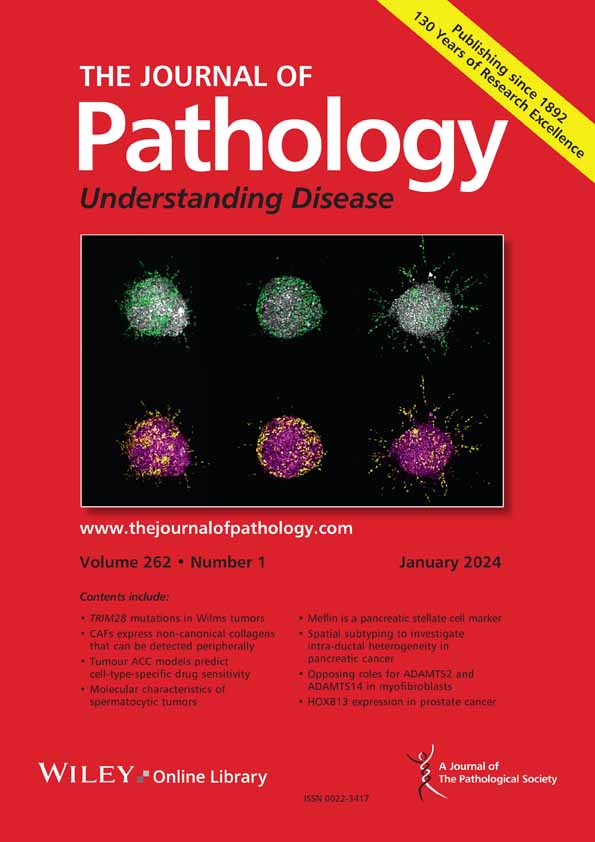Zhengrong Ren, Fang Shao, Shuli Chen, Yanyan Sun, Zhi Ding, Lei Dong, Junfeng Zhang, Yuhui Zang
求助PDF
{"title":"Contribution of alterations in peritubular capillary density and microcirculation to the progression of tubular injury and kidney fibrosis","authors":"Zhengrong Ren, Fang Shao, Shuli Chen, Yanyan Sun, Zhi Ding, Lei Dong, Junfeng Zhang, Yuhui Zang","doi":"10.1002/path.6414","DOIUrl":null,"url":null,"abstract":"<p>Peritubular capillary (PTC) rarefaction is a common pathological feature of chronic kidney disease (CKD). The critical function of PTCs in maintaining blood supply for tubular epithelial cells renders PTCs a promising therapeutic target. However, the role of PTC rarefaction in the progression of kidney fibrosis remains elusive. In this study, we first characterized mice with altered PTC density. CD31 staining, together with microvascular network perfusion with FITC-labelled albumin and laser speckle contrast imaging, revealed a significant increase in PTC density in <i>Flt1</i> heterozygous-deficient mice, whereas homozygous disruption of the plasminogen activator, urokinase receptor gene (<i>Plaur/uPAR</i>), led to a notable decrease in PTC density. Using these genetically distinct mice, we showed that preexisting higher PTC density protected against tubular injury and attenuated the progression of tubulointerstitial fibrosis in two distinct kidney injury models, namely, ischemia–reperfusion injury (IRI) and unilateral ureteral obstruction (UUO). By contrast, <i>Plaur</i>-deficient mice with established lower PTC density displayed exacerbated tubular injury and renal fibrosis when subjected to IRI or UUO. The pathophysiological significance of PTC density was associated with protective effects on tubular cell apoptosis and concomitant regeneration. Finally, vasodilation of the renal capillary with minoxidil, a clinically available drug, effectively prevented UUO-induced tubular injury and renal fibrosis. Moreover, minoxidil treatment abolished the detrimental effect of <i>Plaur</i> deficiency on the UUO-treated kidney, thus suggesting a causative role of PTC density in the susceptibility of <i>Plaur</i> knockout mice to tubular injury following fibrosis. Our results provide an overview of the pathologic significance of PTC density alterations in the progression of CKD, and show that improving peritubular microcirculation is effective in preventing tubular injury and the subsequent renal fibrosis. © 2025 The Pathological Society of Great Britain and Ireland.</p>","PeriodicalId":232,"journal":{"name":"The Journal of Pathology","volume":"266 1","pages":"95-108"},"PeriodicalIF":5.2000,"publicationDate":"2025-03-19","publicationTypes":"Journal Article","fieldsOfStudy":null,"isOpenAccess":false,"openAccessPdf":"","citationCount":"0","resultStr":null,"platform":"Semanticscholar","paperid":null,"PeriodicalName":"The Journal of Pathology","FirstCategoryId":"3","ListUrlMain":"https://pathsocjournals.onlinelibrary.wiley.com/doi/10.1002/path.6414","RegionNum":2,"RegionCategory":"医学","ArticlePicture":[],"TitleCN":null,"AbstractTextCN":null,"PMCID":null,"EPubDate":"","PubModel":"","JCR":"Q1","JCRName":"ONCOLOGY","Score":null,"Total":0}
引用次数: 0
引用
批量引用
Abstract
Peritubular capillary (PTC) rarefaction is a common pathological feature of chronic kidney disease (CKD). The critical function of PTCs in maintaining blood supply for tubular epithelial cells renders PTCs a promising therapeutic target. However, the role of PTC rarefaction in the progression of kidney fibrosis remains elusive. In this study, we first characterized mice with altered PTC density. CD31 staining, together with microvascular network perfusion with FITC-labelled albumin and laser speckle contrast imaging, revealed a significant increase in PTC density in Flt1 heterozygous-deficient mice, whereas homozygous disruption of the plasminogen activator, urokinase receptor gene (Plaur/uPAR ), led to a notable decrease in PTC density. Using these genetically distinct mice, we showed that preexisting higher PTC density protected against tubular injury and attenuated the progression of tubulointerstitial fibrosis in two distinct kidney injury models, namely, ischemia–reperfusion injury (IRI) and unilateral ureteral obstruction (UUO). By contrast, Plaur -deficient mice with established lower PTC density displayed exacerbated tubular injury and renal fibrosis when subjected to IRI or UUO. The pathophysiological significance of PTC density was associated with protective effects on tubular cell apoptosis and concomitant regeneration. Finally, vasodilation of the renal capillary with minoxidil, a clinically available drug, effectively prevented UUO-induced tubular injury and renal fibrosis. Moreover, minoxidil treatment abolished the detrimental effect of Plaur deficiency on the UUO-treated kidney, thus suggesting a causative role of PTC density in the susceptibility of Plaur knockout mice to tubular injury following fibrosis. Our results provide an overview of the pathologic significance of PTC density alterations in the progression of CKD, and show that improving peritubular microcirculation is effective in preventing tubular injury and the subsequent renal fibrosis. © 2025 The Pathological Society of Great Britain and Ireland.
小管周围毛细血管密度和微循环的改变对小管损伤和肾纤维化进展的贡献。
小管周围毛细血管(PTC)稀疏是慢性肾脏疾病(CKD)的常见病理特征。ptc在维持小管上皮细胞的血液供应方面的关键功能使ptc成为一个有希望的治疗靶点。然而,PTC稀薄在肾纤维化进展中的作用仍然难以捉摸。在这项研究中,我们首先对PTC密度改变的小鼠进行了表征。CD31染色、fitc标记白蛋白微血管网络灌注和激光散斑造影显示,Flt1杂合缺陷小鼠的PTC密度显著增加,而纤溶酶原激活物尿激酶受体基因(Plaur/uPAR)的纯合破坏导致PTC密度显著降低。在两种不同的肾损伤模型(即缺血-再灌注损伤(IRI)和单侧输尿管梗阻(UUO))中,我们发现先前存在的较高PTC密度可以防止小管损伤,并减轻小管间质纤维化的进展。相比之下,PTC密度较低的plau缺乏小鼠在IRI或UUO时表现出加重的小管损伤和肾纤维化。PTC密度的病理生理意义与对小管细胞凋亡和再生的保护作用有关。最后,临床可用药物米诺地尔对肾毛细血管进行舒张,可有效预防uuo诱导的肾小管损伤和肾纤维化。此外,米诺地尔治疗消除了Plaur缺乏对uuo治疗的肾脏的有害影响,这表明PTC密度在Plaur基因敲除小鼠对纤维化后小管损伤的易感性中起了导致作用。我们的研究结果概述了PTC密度改变在CKD进展中的病理意义,并表明改善小管周围微循环可有效预防小管损伤和随后的肾纤维化。©2025英国和爱尔兰病理学会。
本文章由计算机程序翻译,如有差异,请以英文原文为准。





 求助内容:
求助内容: 应助结果提醒方式:
应助结果提醒方式:


